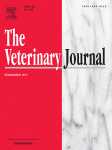View Item
- xmlui.general.dspace_homeCentros Regionales y EEAsCentro Regional Santa FeEEA RafaelaArtículos científicosxmlui.ArtifactBrowser.ItemViewer.trail
- DSpace Home
- Centros Regionales y EEAs
- Centro Regional Santa Fe
- EEA Rafaela
- Artículos científicos
- View Item
Evaluation of the humoral immune response to a multicomponent recombinant vaccine against S. aureus in healthy pregnant heifers
Abstract
Staphylococcus aureus is a worldwide pathogen that causes mastitis in dairy herds. Shortcomings in control programs have encouraged the development of vaccines against this pathogen. This study evaluated the vaccine candidate VacR, which included recombinant S. aureus protein clumping factor A (rClf), fibronectin binding protein A (rFnBP) and hemolysin beta (rBt), formulated with a novel immune-stimulating complex. Comparisons were made between healthy
[ver mas...]
Staphylococcus aureus is a worldwide pathogen that causes mastitis in dairy herds. Shortcomings in control programs have encouraged the development of vaccines against this pathogen. This study evaluated the vaccine candidate VacR, which included recombinant S. aureus protein clumping factor A (rClf), fibronectin binding protein A (rFnBP) and hemolysin beta (rBt), formulated with a novel immune-stimulating complex. Comparisons were made between healthy pregnant heifers that received either VacR (n = 8; VacR group) or phosphate buffered saline (PBS) plus adjuvant (control group) SC in the supramammary lymph node area on days 45 and 15 before the expected calving date. Blood and foremilk samples were collected from 7 to 60 days post-calving.
After calving, heifers in the VacR group produced higher total IgG (IgGtotal) titers against each component, in both serum (rBt, 3.4 × 105; rClf, 3.1 × 105; rFnBP, 2.3 × 105) and milk (rBt, 2.6 × 104; rClf, 1.3 × 104; rFnBP, 1.1 × 104), than control heifers (P < 0.0001). There were increased concentrations of IgG1 and IgG2 in VacR group (P < 0.05), in both serum and milk. Humoral responses remained high throughout the period most susceptible to intramammary infections (P < 0.01). Antibodies produced against S. aureus rClf and rFnBP reduced bacterial adherence to fibronectin and fibrinogen by 73% and 67%, respectively (P < 0.001). Milk antibodies against these adhesins inhibited S. aureus invasion of a mammary epithelial cell line (MAC-T), resulting in 15.7% of bacteria internalized (P < 0.0001). There was an approximately 6-fold reduction in the hemolysis titer for the native hemolysin in the VacR group compared to the control group (P < 0.0001) and a significantly increase in the proportion of positive neutrophils (VacR, 29.7%; PBS, 13.1%) and the mean fluorescent index (VacR, 217.4; PBS, 152.6; P < 0.01) in the VacR group. The results suggest that VacR is a valuable vaccine candidate against S. aureus infections, and merits further field trials and experimental challenges.
[Cerrar]

Author
Pujato, Nazarena;
Camussone, Cecilia;
Renna, María Sol;
Perrig, Melina Soledad;
Morein, Bror;
Calvinho, Luis Fernando;
Marcipar, Iván Sergio;
Fuente
The Veterinary Journal 235 : 47-53 (May 2018)
Date
2018-05
ISSN
1090-0233
Formato
pdf
Tipo de documento
artículo
Palabras Claves
Derechos de acceso
Restringido
 Excepto donde se diga explicitamente, este item se publica bajo la siguiente descripción: Creative Commons Attribution-NonCommercial-ShareAlike 2.5 Unported (CC BY-NC-SA 2.5)
Excepto donde se diga explicitamente, este item se publica bajo la siguiente descripción: Creative Commons Attribution-NonCommercial-ShareAlike 2.5 Unported (CC BY-NC-SA 2.5)

